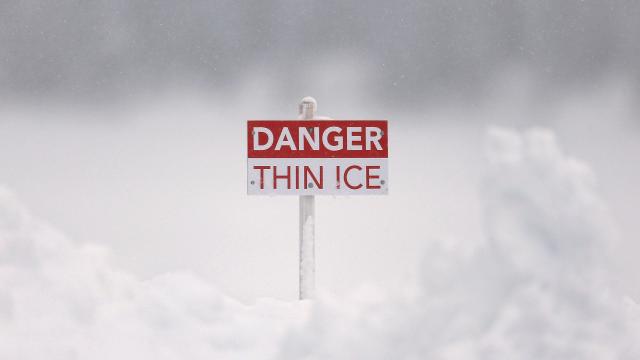Growing up in New England, I used to spend winter weekends skating on ponds and the occasional drainage ditch in the middle of a six-lane road (it was the suburbs, OK?). Millions of other people around the world have similar memories of skating, ice fishing, and other wintery outdoor activities.
But the ice that undergirds those memories is weakening. And what were once safe places are now becoming more dangerous. A new paper published in PLOS ONE on Wednesday chronicles more than 25 years of wintertime drowning deaths, and the results show that rising temperatures are making our leisure time more perilous and unravelling the very culture of cold-weather locales.
[referenced id=”1530304″ url=”https://gizmodo.com.au/2020/11/greenlands-most-threatened-glaciers-are-in-even-more-danger-than-we-thought/” thumb=”https://gizmodo.com.au/wp-content/uploads/2020/11/18/gyoln3tkxtnydxebaqtx-300×169.jpg” title=”Greenland’s Most Threatened Glaciers Are in Even More Danger Than We Thought” excerpt=”Someday, I would like to write a happy story about ice. Today is not that day.”]
The research brings together a network of lake researchers. In fact, it began through connections fostered as part of the Global Lake Ecological Observatory Network, a project that’s exactly what it sounds like. Sapna Sharma, an ecologist by training at Canada’s York University, said she was speaking with researchers in the network and mentioned a local wintertime drowning near Toronto. Another Swedish researcher said a similar drowning had occurred there, and that’s what set the ecologists on the hunt to understand the human ramifications of the changes they were monitoring.
“We know from our research ice is changing rapidly, especially in the last few decades,” Sharma said. “Climate change is happening in our backyard, so to speak. These lakes and rivers and creeks, wherever you are enjoying or working on them, that’s your backyard.”
Previous studies have looked at the rise in wintertime drownings in specific locations, such as within northern Canada’s Indigenous communities. But the team of 16 scientists was able to comb through data in 10 countries across the northern hemisphere where it gets cold enough for inland waters to freeze. The international nature of the team allowed to scour data sources in local languages, including coroners’ offices, police, search and rescue groups, and national statistics
The findings show that from 1991 to 2018, 4,000 people died from wintertime drowning. The data doesn’t include those who survived and possibly live with long-term health issues that come with losing oxygen to the brain for a prolonged period, indicating the results are a conservative estimate of the impacts. The group correlated the death with climate data and found that drownings increased exponentially in regions when the temperature neared freezing. The most dangerous range of temperatures ran the gamut from 23 to 32 degrees Fahrenheit (-5 to 0 degrees Celsius), temperatures that, while below freezing, can still lead to weaker and thinner ice.
Depressingly, young children made up the highest portion of those who drowned. Young adults up to 39 years old were also more likely to die from wintertime drowning, particularly when a light vehicle like a snowmobile was involved. It points to well-worn ideas that kids are generally less aware of their surroundings and that young adults are more likely to engage in reckless behaviour. But the results also show that as the planet warms, the impacts will extend to even the most seemingly benign activities.
“We have to disconnect from what we thought of winters from the past and what we thought was normal,” Sharma said. “That’s changing now. That’s changed already, and we need to adapt our decisions on whether we can go skating at Christmas or we can go ice fishing at New Year’s. We can’t do that anymore safely. So I think that’s part of our connection with nature is realising that it’s changing and accepting that.”
The study’s results point to the need for more research and clear warnings of how climate change could affect the formerly frozen season. Ice is already forming later and receding earlier, but mid-season thaws followed by a refreeze are also a huge concern. That can create what researchers call “grey ice” that’s slushy and less stable, though it may appear OK to skate, stand, or otherwise recreate on. As Sharma put it, ice has a “memory” that can span a season even if we’re quick to forget.
One solution, then, is to help educate people to take a big-picture view of ice and weather across the entire season rather than the past few days. The paper notes Cree hunters take this approach to assess ice conditions, and Sharma said “incorporating that traditional knowledge is going to be very important in designing winter safety plans.” It also includes ensuring parents are educated on the changes in ice behaviour and temperatures so they can pass that along to children, as well as educating young adults on heeding commonsense rules like not going on ice at night, when mushy spots may be tough to spot, and cooling it on snowmobiles. If it requires me to show up and yell “get off my pond,” I’m willing to do that.
But really, the study shows we have to let go of the past. What once was is being obliterated by the climate crisis. Yes, there will still be cold winters. But pastimes are in danger of becoming just that.
